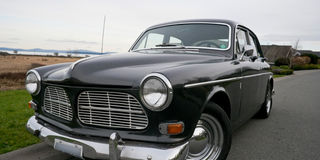Prime
Down memory lane in Volvo 122s

What you need to know:
The sight of some vehicles conjures sweet memories that are unfortunately almost impossible to relive. One of the cars that lives up to that bill is the Volvo 122S whose engineering and design were impeccable, endearing it to many
George William Mulindwa, the founder of Makerere Volvo garage, as of his demise, in 2020 had been a mechanic for several years. Apart from being an owner of a genuine Volvo garage, one of Mulindwa’s most prized possessions was the Volvo Estate 145 (1975 model). Before that, he had owned the Volvo 122, model 1966 and the Volvo 144, model 1968. Indeed, he was a lover of Volvos, claiming there was no car that was as stable as them. Mulindwa kept his car in impeccable condition and refused to part with it no matter how many tempting offers he got.
At the sight of such a Volvo, more so when driven by an elderly man brings back memories of the EA Safari Rally when many awoke in the wee hours of the night to watch these Volvos, 504s, Ford Escorts, Mercedes zoom by at breakneck speed. Those were the days of no-high-tech, pedal-to-the-metal pure rallying. That Volvo 122S sure brings back good memories.
Indeed, such a sighting is as rare as a unicorn pulling a sled ridden by St Nick and Beelzebub while sharing a glass of vegetable juice in the middle of the day. The 122 is not a common car, more so given its vintage. The car has to be at least 49 years old, if not 63 (production started in 1956). The Estate was a prototype of a new passenger car from Volvo.
Called the Sweden or Amason by others yet badged the 121 and 122S on the export market, this Volvo was the world’s first car to offer front seat belts as standard. Later, it was also the first to offer three-point belts as standard as well.
This version was an eagerly awaited model, more so in Sweden where all they had were the two door cars then. Introduced in 1962 until 1969, only 73,000 pieces were made.
The car came with a two-piece tailgate where the lower section folded down to provide a load surface while the upper section hinged overhead. Its rear license plate was attached to its lower tailgate. That enabled it to fold up in that even when the tailgate was lowered, the number plate was still visible.
While a handful may still have the original 122 just as Mulindwa did hence earn a 20-year guarantee for repair, in some parts of the world, such as South Africa, it has been remodeled.
In the case of the South African remodel, the original engine block was changed from 1.8 litres to two litres. That was to make it compatible with Mercedes SLK pistons which were the closest fit for the vintage. It was also given the Mercedes Kompressor supercharger which lends it great performance. Additionally, the interior is really impeccable with re-trimmed black leather. Its front suspension was also slightly lowered while the rear was raised all to give it top notch performance.
In Britain, another was remodeled with a 2036cc engine block, coupled with a heavy duty servo, a high lift camshaft and the official Volvo performance tuning kit. A few modifications were given the vintage such as the Swedish police alternator. When tested, the gem had brake horsepower of 146BHP. Another modification was a low ratio back axle which did away with the axle tramping which caused the right and left side wheels to hope out of phase meaning quick acceleration was not possible before then. With this fitting, it ably performed in all the competitions it became part of.
The car was also fitted with Solex Carburetors which date back to 1970. That addition fitted well because the car and the modification were all from years behind us.
These old Volvos still see motorsports action in their Scandinavian homeland; particularly in neighbouring Finland. That it is evocative of the old days of rally cannot be gainsaid, and much as the 122/Amason never saw glory like the other marques you mention back then, it would make a handy steed for the East African Classic Safari that loops around the coastal, Kilimanjaro region every year. It may never win either, those Porsches are something else, but it would be reliable and a lot more comfortable.
General Information
When introduced, the car was named the Amason (with an‘s’), [7] deriving from the fierce female warriors of Greek mythology, the Amazons.
The Amazon shared the wheelbase, tall posture and high H-point seating of its predecessor, the PV444/544, and was offered in two-door sedan, four-door sedan, and five-door wagon body styles — all noted for their ponton styling. In 1959 Volvo became the world’s first manufacturer to provide front seat belts as standard equipment — by providing them on all Amazon models,[8] including the export models[8] — and later becoming the first car featuring three-point seat belts as standard equipment.
The 122S introduced in 1958 as a performance model equipped with a dual carburetor 85 bhp (63 kW) engine.
Wikipedia





